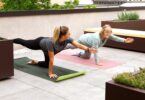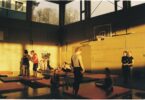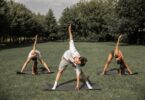Yoga has long been known to have many benefits for people of all ages, but it can be especially beneficial for older adults. Yoga can help improve flexibility, balance, strength, and overall physical and mental well-being. However, as we age, it can become more difficult to attend a traditional yoga class in person, whether it be due to mobility issues or simply feeling self-conscious. Fortunately, there are many ways to practice yoga at home, whether alone or in small groups.
Yoga for 50+
Yoga can be a great way for people over the age of 50 to stay active and healthy. Many yoga poses can be modified to accommodate any physical limitations and can be done at a pace that is comfortable for the individual.
Benefits of Yoga for Seniors
Yoga can have many benefits for older adults, including:
- Improved flexibility: Yoga poses can help to stretch and strengthen the muscles, which can help to improve overall flexibility.
- Better balance: Yoga poses such as the tree pose and warrior III can help to improve balance, which can be especially important as we age.
- Increased strength: Yoga poses such as the plank and downward-facing dog can help to build strength in the arms and core.
- Reduced stress: Yoga focuses on breathing and relaxation, which can help to reduce stress and improve overall mental well-being.
- Improved sleep: Yoga can help to relax the mind and body, which can lead to better sleep.
Senior Yoga Class
If you’re looking for a way to practice yoga with others, consider joining a senior yoga class. Many yoga studios and community centers offer classes specifically for older adults. These classes may be taught at a slower pace and with modifications to accommodate any physical limitations.
Finding a Senior Yoga Class
- Check with your local yoga studio or community center to see if they offer senior yoga classes.
- Look for classes that are labeled as “gentle” or “chair” yoga, as these classes may be more appropriate for older adults.
- Ask for recommendations from friends or family members who have experience with yoga.
Yoga at Home
If you’re unable to attend a traditional yoga class, there are many ways to practice yoga at home. Whether you’re practicing alone or in a small group, it’s important to make sure you’re using proper form and alignment to avoid injury.
Tips for Practicing Yoga at Home
- Start with a beginner’s yoga video or class: There are many yoga videos and classes available online that are specifically designed for beginners. Look for videos that focus on proper form and alignment and that offer modifications for any physical limitations.
- Use a yoga mat: A yoga mat can provide a non-slip surface and cushion for your joints.
- Use props: Blocks, straps, and blankets can be used to help with balance and alignment in certain poses.
- Listen to your body: Yoga should never be painful. If you feel any discomfort, stop the pose and try a modified version or rest in the child’s pose.
- Practice regularly: To see the full benefits of yoga, it’s important to practice regularly. Aim for at least 20-30 minutes of yoga each day.
In conclusion, Yoga is a great way for older adults to stay active and healthy, and it can be done at home with the right resources and tips. It’s important to remember to listen to your body, use proper form and alignment, and practice regularly. Whether you choose to practice alone or in a small group, there are many benefits to be gained from yoga as we age. Whether it’s improved flexibility, balance, strength, or reduced stress, yoga can help to improve overall physical and mental well-being. If you’re looking for a way to practice yoga with others, consider joining a senior yoga class or look for classes labeled as “gentle” or “chair” yoga. With the right resources and tips, practicing yoga at home can be a great way for older adults to stay active and healthy.








Leave a Comment